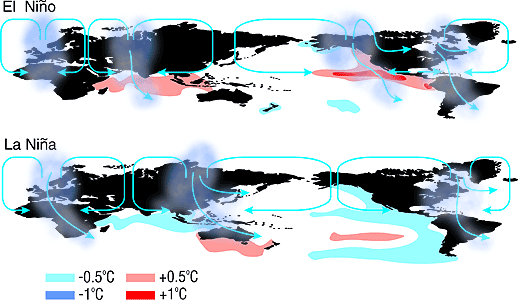|
Understanding drought
Information sheet
The 1991-95 Australian drought was as long as any in living
memory. Depending on whom you speak to, the cause was either a single
persistent El Niño, or a series of El Niño events, each
following on the heels of its predecessor.

Typical air movements and changes to ocean surface temperatures during an
El Niño and La Niña event.
What is El Niño?
At Christmas a warm current usually appears in the Pacific
off the coast of Peru. This warm water displaces nutrients that normally
sustain enormous fish stocks. Because of the time when the fishing season
is temporarily disrupted, the Peruvians refer to the start of the warm
current as El Niño, Spanish for Christ child.
Now we use the term El Niño for a far more widespread event, one
that arises on average at 2–7 year intervals. El Niño often
affects weather patterns across much of the planet.
Normally, Pacific Ocean trade winds propel surface water in a westerly
direction along the equator. This permits warm water to accumulate in
the western equatorial Pacific, to the north-east of Australia, heating
air in contact with it. The warm, moist air produces clouds and rain.
However, from time to time this process is disrupted. Trade winds and
tropical Pacific currents weaken. Warm water in the western Pacific off
Australia is displaced to the central Pacific. Clouds disappear and much
of Australia is plunged into drought. Simultaneously, in parts of north
and south America, heavy rain begins to fall. An El Niño event
has begun.
Measuring El Niño
The strength of El Niño is assessed in part by a
measure known as the Southern Oscillation Index (SOI). The index is determined
by the difference in barometric pressure between Tahiti and Darwin. Pressure
see-saws between the two locations, normally being higher in Tahiti than
in Darwin. During El Niño the opposite condition prevails, taking
the SOI to negative values.
The latest research
The CSIRO Climate Variability and Impacts Multi-Divisional
Program is conducting research into the causes and impacts on Australia
of climate variability. The Program involves scientists from fourteen
CSIRO Divisions, the Bureau of Meteorology, the Bureau of Resource Sciences
and other agencies.
By Paul Holper
August 1996 |